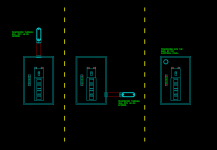Service install. Trying to keep it simple. Below are three mock ups. If you penetrate a wall and do not terminate the conduit directly into the panel (right image) is an LB acceptable (left & middle)? The LB would allow access to the unprotected service entrance conductors. For the sake of argument, lets say the conduit length is no longer than 24". Assume panels are mounted 6'-0" to the top.



